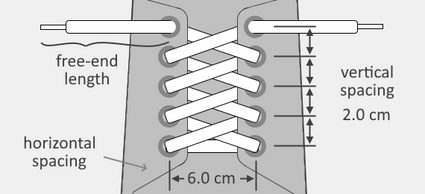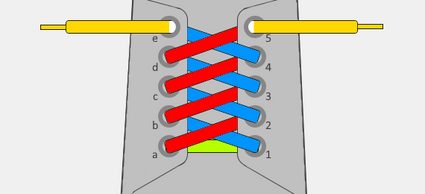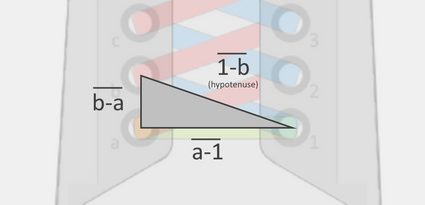Shoelace Length Calculator
This shoelace length calculator will help you answer the question "How long of shoelaces do I need?" to achieve a particular lace pattern on your sneakers or boots. This calculator is also a perfect shoelace length guide if you want to flash some cool shoelace patterns, and you are simply out to buy a new pairs of shoelaces.
You can also check the designs available in this shoelace length calculator to determine how to tie a long shoelace onto any shoe size.
Shoes and shoelaces
Shoes are footwear that comes in many designs and structures suitable for different occasions and purposes. But whatever purpose it might be, most of us prefer to wear shoes that perfectly fit us. Speaking of a perfect fit, if you're planning to buy a nice pair of jeans or a chic dress, you might want to check out our jeans size calculator or the dress size calculator to see what size best fits you.
Back to the topic at hand, shoes can be worn as a slip-on, or they can have an adjustable opening to slide our feet through comfortably. The adjustment of these openings can be made with straps, zippers, elastics, and shoelaces, to name a few. In this article, our primary focus will be on shoelaces.
Shoelaces can come in fixed lengths, or you could make your own customized shoelace length to suit your needs. When customizing your laces, you could choose, for example, cotton, nylon, or leather for your shoelace material. To protect the shoelace ends from fraying, it is best to use aglets that are typically made from metal or plastic. Aglets also make threading the lace through the shoe's eyelets easier. In some cases, aglets can even add to the aesthetics of the shoe.
How long of shoelaces do I need? Shoelace length calculator
Laced shoes usually come with a pair of shoelaces. However, getting creative with our shoelaces' patterns might require us to either get longer or shorter shoelaces to achieve the look we desire. Simpler designs could be met with the included laces, while more intricate designs might need longer shoelaces. It is also worth considering if you need additional lace at the free end to tie your shoelaces with. However, in some shoelace patterns, the free ends can be tucked inside the shoes or left sticking out of their eyelets, as they're tight enough already.
You can determine the required length of your shoelaces through trial and error with different lengths of shoelaces. However, if you fancy doing it with mathematics, you've come to the right place. Our shoelace length guide is here just for you! Since there are now many different shoelace patterns to choose from, we'll only cover the essential steps in calculating the required length of shoelaces. For us to do this, let us consider one of the simplest shoelace patterns: the basic criss-cross. Below, we can see the basic criss-cross pattern with the necessary dimensions to determining the shoelace's length:

In the above illustration, five pairs of eyelets are spaced 2 centimeters from each other (vertically), and 6 centimeters apart (horizontally). The basic criss-cross starts by threading the shoelace through the first pair of eyelets. After that, the pattern continues by threading the lace into the next eyelet on the opposite side. We repeat in this fashion until we get to the last eyelet.
To determine the shoelace length of any pattern, we need to:
- Know the lengths of shoelace segments connecting any two eyelets.
- Add all these lengths together
- Finally, we also add our desired length of free ends.
In the basic criss-cross pattern, we can see a repetitive diagonal connection between the eyelets that we highlighted with blue and red in the illustration below:

We also labeled the eyelets with letters and numbers so we can easily pinpoint a specific part of the shoelace pattern. Now, with the help of a mathematical concept called the Pythagorean theorem, we can determine the length of each diagonal portion in our shoelace pattern.
Learn more about this theorem used for right triangles at our Pythagorean theorem calculator
What we'll be doing is calculating the hypotenuse of the triangle formed by the three eyelets involved in this pattern, as shown below:

For our example above, we can use the Pythagorean theorem to solve for the length of the diagonal part 1-b by taking the square root of the sum of the squares of the horizontal and vertical measurements:
length of diagonal part = √(horizontal spacing² + vertical spacing²)
length of diagonal part = √(6² + 2²)
length of diagonal part = √(36 + 4) = √40
length of diagonal part = 2√10 ≈ 6.32 centimeters
Since there are four pairs of these diagonal segments, we can say that the entire pattern would use up approximately:
6.325 cm × 4 pairs × 2 (diagonals per pair) = 50.60 cm
of shoelace length to complete the pattern. However, we still need to add the horizontal part we threaded in the start (highlighted in green) and the length of free ends (highlighted in yellow). Each free end could be around 3 to 5 centimeters for tucked-in ends, and up to 10 cm to 20 cm for knotted ends. For our basic criss-cross, we want around 15 cm ends to be tied with a simple bow knot (actually, you don't need to think how to tie long shoelaces right now, it should all come together once you have threaded your laces). We can then finally calculate our total needed shoelace length:
total length = length of diagonals + initial threading + (free ends length × 2)
total length = 50.60 cm + 6 cm + (15 cm × 2)
total length = 86.60 cm or approximately 90 cm
With our example above, we can now say that we would need a pair of 90-cm shoelaces for the given pair of shoes to achieve the basic criss-cross pattern with a knotted bow as a finisher. It may seem like an exhausting process, but don't worry! We have implemented all of this in our online shoelace length guide. Just give it a try!
Shoelace length for cool shoelace patterns
For other cool shoelace patterns, it would benefit from having a visual representation of the design you wish to replicate in front of you. In this way, you won't miss any portion in your calculation. Other patterns may have hidden parts, or they may have segments where the shoelace is threaded twice and overlaps itself. In such cases, it's good idea to think about how to tie long shoelaces. Always make sure you have noted down all the hidden parts and double segments to get the correct total length.
You wouldn't want to get a pair of laces to find out you are short a centimeter or two. Nevertheless, by using our shoelace length calculator, you'd be worry-free with these errors because all you have to do is input the dimensions of your shoelace eyelets and your preferred free end length. However, if you decided to go beyond the options we provided in our shoelace length calculator, please be extra careful with your calculations.
For another example, we have here an illustration of how you can use the Pythagorean theorem to solve for the diagonal segments' lengths in the "starburst" pattern:

length of segment d-2 = √(horizontal spacing² + (2 × vertical spacing)²)
length of segment e-1 = √(horizontal spacing² + (4 × vertical spacing)²)
Want to learn more?
Now that you know how to determine how long of shoelace you need for your chosen pattern, you might have time to check out our lost socks calculator. In that calculator, you will learn about how many socks you lose per month and tips on how to avoid losing socks ever again.
